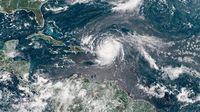On August 19, 2025, Hurricane Erin continued its slow, menacing crawl toward the eastern United States, sending coastal communities from Florida to New England into a state of heightened alert. The storm, which had already carved a path of disruption through the Caribbean, was responsible for dangerous surf, life-threatening rip currents, and a flurry of emergency preparations along the Atlantic seaboard, according to reports from FRANCE 24, ABC News, and the Associated Press.
The U.S. Air Force underscored the seriousness of the situation by releasing dramatic footage of one of its planes flying directly into the eye of Hurricane Erin. While such missions are routine for hurricane hunters, the timing of the release—just as the storm’s outer bands began lashing the coast—served as a vivid reminder of the storm’s intensity and unpredictability.
Forecasters at the National Hurricane Center in Miami said by Tuesday, Erin had weakened slightly from its earlier ferocity, dropping to a Category 2 hurricane with maximum sustained winds of 105 mph (170 kph). Still, the storm’s sheer size made it especially worrisome. Its tropical storm-force winds stretched 200 to 230 miles (320 to 370 kilometers) from its core, meaning that even communities far from the storm’s center were at risk of dangerous conditions.
At 615 to 655 miles (990 to 1,050 kilometers) south-southeast of North Carolina’s Cape Hatteras, Erin’s outer bands were already generating treacherous waves and rip currents. The National Weather Service posted warnings about rip currents from Florida all the way to New England. New York City responded by closing its beaches to swimming on Wednesday and Thursday, August 20 and 21, with similar closures affecting Long Island and New Jersey beaches.
“Enjoy the shore, enjoy this beautiful weather but stay out of the water,” New Jersey Governor Phil Murphy cautioned on Tuesday, as quoted by the Associated Press. The advice was more than prudent: at Wrightsville Beach near Wilmington, North Carolina, at least 60 swimmers had to be rescued from rip currents on Monday alone, highlighting just how quickly conditions could turn perilous.
Off the coast of Massachusetts, Nantucket Island braced for waves exceeding 10 feet (3 meters) later in the week. Yet, the most immediate threat loomed over North Carolina’s Outer Banks—a fragile chain of low-lying barrier islands that jut into the Atlantic and have become increasingly vulnerable to storm surges. Local officials warned that storm surges could produce waves up to 15 feet (4.6 meters), with the potential to swamp roads and sever access to critical infrastructure.
Mandatory evacuation orders were issued for Hatteras and Ocracoke Islands. Over 1,800 people had already left Ocracoke by ferry since Monday, with more expected to follow as the situation developed. North Carolina Governor Josh Stein declared a state of emergency on August 19, urging residents to prepare for evacuation at a moment’s notice. “It’s just one of those things where you know this is always a possibility and it could happen, and you just make the best out of it. Otherwise you wouldn’t live at the beach,” said Holly Andrzejewski, a new bed-and-breakfast owner on Hatteras Island, reflecting a sentiment echoed by many coastal residents.
Preparations were underway up and down the coast. Bulldozers shored up dunes in anticipation of the storm surge, and the owners of a pier on Hatteras removed several planks, hoping the surge would pass through without destroying the structure. Still, memories of past hurricanes lingered. Randal Mathews, a county commissioner, recalled how Hurricane Dorian in 2019 brought seven feet (2.1 meters) of water to Ocracoke, a stark reminder of the islands’ vulnerability. Yet, not everyone was ready to leave. Tom Newsom, a fishing charter operator who has lived on Hatteras for nearly four decades, said he had never evacuated and wasn’t planning to this time, describing Erin as “a nor’easter on steroids.”
Further south, no mandatory evacuations had been ordered as of Tuesday, but some beach access points were closed as forecasts predicted water levels up to three feet (one meter) above normal high tides for several days. Local leaders in one town even asked residents to secure their trash cans to prevent them from floating or blowing away—an oddly mundane but telling sign of the meticulous preparations underway.
While forecasters remained confident that the core of Hurricane Erin would remain offshore, they cautioned that its outer edges could still bring damaging winds, large swells, and life-threatening rip currents well into Friday. The biggest swells along the East Coast were expected to develop Wednesday and last through Thursday, threatening to erode beaches and inundate coastal roads.
Government services in the Turks and Caicos Islands had already been suspended a day earlier as Erin lashed the region, with residents ordered to stay home. Parts of the Bahamas were also affected before the storm was predicted to turn toward Bermuda and the United States. Tropical storm watches were issued for Virginia, North Carolina, and Bermuda as a precaution.
Climate scientists, cited by Global News and the Associated Press, pointed to Hurricane Erin as yet another example of how Atlantic hurricanes are becoming larger and more intense, fueled by increasingly warm ocean waters. They noted that, much like Hurricane Lee two years earlier, Erin had shown the potential for rapid intensification—a trend that is raising new concerns about the unpredictability and destructive power of future storms.
Local economies, especially those dependent on summer tourism, faced additional anxieties. Bryan Philips, a resident of the Outer Banks, remarked, “That’s their main concern: getting tourists back on the island as soon as possible.” The hope is that roads would reopen by the weekend, salvaging at least part of the crucial late-summer tourist season.
As Hurricane Erin churned northward, the sense of urgency was palpable but so was a measured resilience. Residents and officials alike were taking no chances, drawing on hard-earned experience from storms past. With mandatory evacuations in place, emergency declarations issued, and the Air Force flying into the storm’s very heart, the eastern U.S. braced for the full measure of Erin’s power—hoping, as always, for the best, but preparing for whatever the Atlantic might deliver.






